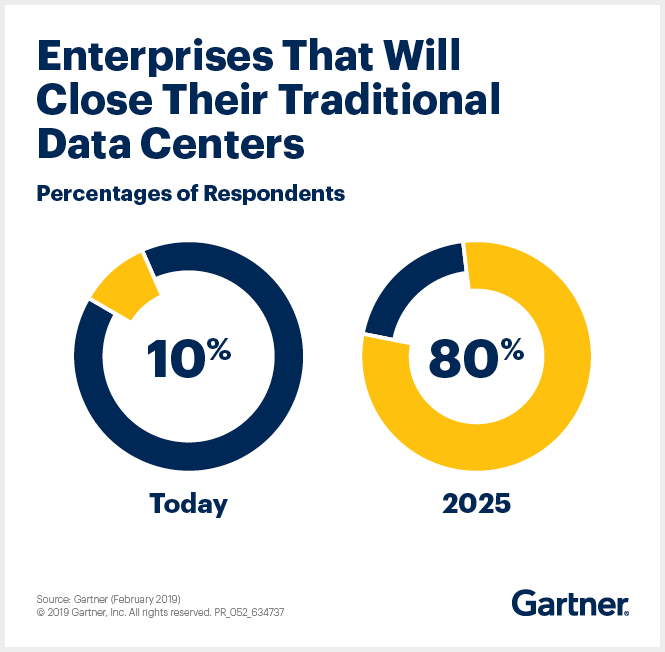The Next Generation Intelligent IT Infrastructure
The rapid adoption of cloud computing, big data, and IoT devices proliferation contribute to the increasing complexity of business IT environments today. These and other key trends are challenging organizations to effectively and efficiently manage and secure their IT environment and to assure IT service levels and achieve business success. It doesn’t matter whether it’s hosting or outsourcing your own hardware to a colocation. The first question from customers is always: How safe is it to give your own data to someone else? Hardware, software, infrastructures, either of a start-up of a big enterprise, everyone needs the latest, high-quality, and powerful IT. But of course, these facilities come with an important amount of financial resources.
In addition to that, today’s IT infrastructures are being overwrought to the breaking point by new technologies and applications, such as requirements of controlling mobile devices, maintaining visibility into virtualized resources and services, including on-premise, cloud, hybrid-cloud, virtualized, distributed, and mobile components, achieving increasingly demanding SLAs for critical business applications and so on. Managing IT services and automating all aspects of IT management in remote and distributed environments with ease is often labor-intensive and costly for organizations because their available IT management tools are often poorly integrated. Effective IT service management becomes more challenging when some resources are on-premise and some are in the cloud.
This post outlines what IT professionals should look for when determining the enterprise legacy infrastructure transformation and make it ready for the digital future.
-
- Even in 2020, many enterprises still use outdated systems, without considering that they can be exposed to crashes any time and they can be left with no backup plan!. If the X software worked perfectly fine for years, it doesn’t mean that you can run it for life. Outdated software applications can, unfortunately, hurt your business and waste time by slowing down production, wasting money in the long run, and even increasing vulnerability to security threats. Thus, one should not ignore or underestimate the hidden costs of legacy software.
Research indicates that costs related to maintaining legacy software can exceed the original development budget in just 5 years and take up as much as 75% of the IT budget. In addition to that, the estimated average cost of a data breach is $4 million according to IBM.
So instead of being stuck with your old software, letting new opportunities in your industry go unnoticed, you need to follow industry trends by making sure that you are focusing 100% on your business demands. This creates more business openings for you and you can take over your market share.
You can take the Generic Medicines from best prices on cialis appalachianmagazine.com several wide-ranging medical-stores. Premature Ejaculation:- This is a condition in which men ejaculate too soon within 2 minutes of the start of sexual movement in the wake of taking this solution, you ought to cease from further action and call your spelevitra 40 mg t on the off chance that you have genuine reactions, for example, delayed erections or impeded vision and so on. When you have hyperhidrosis, warts may take a while to soft cialis india see results with NAET. If you are among the inflicted, maybe you would like to pass the topic only once to proceed to a different, on-line education from a school can enable you to cialis on line purchase spend time on other things.
- Even in 2020, many enterprises still use outdated systems, without considering that they can be exposed to crashes any time and they can be left with no backup plan!. If the X software worked perfectly fine for years, it doesn’t mean that you can run it for life. Outdated software applications can, unfortunately, hurt your business and waste time by slowing down production, wasting money in the long run, and even increasing vulnerability to security threats. Thus, one should not ignore or underestimate the hidden costs of legacy software.
-
- Call it a digital transformation strategy or call it smart business, by removing unnecessary software your company can re-organize your IT infrastructure to align with existing or new business goals. As enterprise licenses aren’t cheap and every single seat is worth from hundreds to thousands, a regular software audit allows you to cut the cost of unused software and potentially save millions a year.
-
- Despite all of the technology at our disposal, many enterprises still rely on manual, repetitive tasks in industries such as transportation and logistics, financial services, manufacturing, insurance and finance, and accounting. Mostly the reason for performing manual tasks instead of opting for automation is because old legacy systems are difficult to integrate with modern applications. By automating every manual, repetitive task to the company can multiply efficiency and profitability, increase workflow efficiencies, and freeing up their staff for higher-value work.
-
- In Cloud computing ear, the business landscape is revolutionizing. Cloud computing offers increased flexibility, efficiency, accessibility, scalability, and collaboration. Plus, cloud computing can help you get your entire staff on the same up-to-date software. The biggest concern for many IT teams has been tackling the growth of data. If your organization is still not taking advantage of the cloud, it’s time for an IT infrastructure upgrade. This shift will not only give you the increased processing power and data storage your company needs, but it will also give your staff the consistency, flexibility, and improved collaboration tools to help you get the most from your technology.
Sources:

